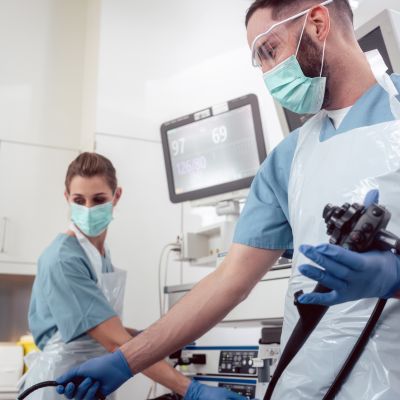An endoscopy is an important diagnostic medical procedure. Using a slender, flexible tube equipped with a camera and light source, physicians can visually inspect internal organs. Endoscopies help identify issues such as:
- Tumors
- Inflammation
- Ulcers
This is accomplished with minimal invasiveness, leading to quicker diagnoses and targeted interventions.
Endoscopic procedures reduce patient discomfort, expedite recovery, and enhance the precision of medical treatments. These factors make endoscopies an indispensable tool in modern healthcare diagnostics.
Endoscopy in Evansville, Indiana
Every surgeon at Evansville Surgical Associates is board-certified and dedicated to meeting the needs of Evansville, IN, and the Tri-State area.
What Is Endoscopy?
Endoscopy is a medical procedure that involves the use of an endoscope, a flexible tube with a light and camera at its tip, to visually examine the interior of the body. The light illuminates the internal body cavity, while the camera captures real-time images. Fiber optics or miniature lenses transmit the visual data to an eyepiece or a video monitor. Advanced endoscopes may include channels for additional tools.
This minimally invasive technique allows physicians to investigate and diagnose various medical conditions without resorting to more invasive surgical procedures.
Endoscopic procedures are versatile, with specific procedures tailored to examine different areas of the body. They can help with a wide range of conditions ranging from gastrointestinal disorders to respiratory or orthopedic issues.
Types of Endoscopic Procedures We Provide
We specialize in two types of endoscopic procedures at Evansville Surgical Associates:
- Upper gastrointestinal endoscopy
- Colonoscopy
Upper gastrointestinal endoscopy, also known as esophagogastroduodenoscopy (EGD), involves the insertion of an endoscope through the mouth. This allows your doctor to examine the esophagus, stomach, and the first part of the small intestine (duodenum). It’s commonly used to diagnose conditions like ulcers, inflammation, or tumors in the upper digestive tract.
During a colonoscopy, an endoscope is inserted through the rectum to visualize the entire colon. It is a crucial screening tool for colorectal cancer, as well as for detecting and removing colorectal polyps. Colonoscopy is effective in identifying abnormalities, inflammation, and other conditions in the lower gastrointestinal tract.
Both procedures play essential roles in diagnosing and managing digestive system disorders. They offer a minimally invasive alternative to traditional surgical methods.
How Does an Endoscope Work?
An endoscope is a medical device used for visualizing and diagnosing the interior of various body cavities. It comprises a flexible tube housing several key components.
At its tip, there is a light source that illuminates the targeted area, allowing for clear visibility. The light can be transmitted using fiber optics or through the use of light-emitting diodes (LEDs). Alongside the light source is a camera, often equipped with a special device or sensors that capture high-quality images of the body’s internal structures. The camera is vital for providing real-time visuals during the procedure.
The visual data captured by the camera is then transmitted through the endoscope to an eyepiece or displayed on a video monitor. Advanced endoscopes may also feature additional channels allowing for the insertion of various tools or instruments, facilitating therapeutic interventions.
Imaging technologies play a pivotal role in endoscopy, enhancing the clarity, resolution, and color accuracy of the captured images. Video processors within the endoscope convert analog signals into digital format, enabling the display of high-quality images and facilitating documentation or recording of the procedures.
Therapeutic Uses for Endoscopes
Endoscopic procedures serve therapeutic roles, including polyp removal and tumor biopsy. In polyp removal, your physician identifies and removes abnormal growths within the GI tract, preventing potential complications like bleeding or obstruction. This technique is particularly vital for colorectal cancer prevention, as polyps can be precursors to malignancies.
Additionally, endoscopes are a key diagnostic and therapeutic tool in oncology. By accessing various anatomical regions, such as the GI or respiratory tracts, endoscopy facilitates the precise sampling of suspicious lesions for pathological examination.
This aids in:
- Determining the nature of tumors
- Guiding treatment decisions
- Assessing their responsiveness to therapy
The therapeutic applications of endoscopy underscore its significance in enhancing patient outcomes. The procedure is essential for minimizing invasiveness and expediting targeted interventions for diverse medical conditions.
What to Expect During Your Procedure
Before your endoscopy, your doctor will provide you with specific instructions on how to prepare. This typically involves:
- Fasting for a certain period beforehand
- Discontinuing certain medications
- Discussing any allergies or medical conditions
Sedation
Upon arrival, you’ll be asked to change into a hospital gown. You may receive a sedative to help you relax during the procedure. However, local anesthesia may be used to numb specific areas in some cases.
Insertion
The endoscope is then carefully inserted through your mouth, nose, or other entry points, depending on the type of endoscopy procedure being performed. The choice of entry point is based on the area of the body being examined, such as the esophagus, stomach, or colon.
As the endoscope advances, the camera sends real-time images to a monitor, allowing your doctor to thoroughly inspect the lining of the organs. In certain cases, therapeutic interventions like removing tissue samples (biopsy), cauterizing bleeding vessels, or removing polyps may be performed.
You may feel mild discomfort throughout the procedure. Fortunately, the sedation helps alleviate anxiety and discomfort.
Next steps
After the procedure, you’ll be monitored until the effects of the sedative wear off. It’s common to experience some bloating, gas, or a sore throat afterward, but these symptoms typically subside quickly. Your doctor will discuss the initial findings with you and provide additional information based on any samples taken during the procedure.
It’s important to follow post-procedure care instructions, including any restrictions on eating or activities, to ensure a smooth recovery. It’s crucial to contact your healthcare provider promptly if you experience severe pain, fever, or persistent bleeding after the procedure.
Potential Risks and Complications
All surgical procedures come with some risk. Thankfully, the risk of complications associated with endoscopic procedures is low and instances are rare. Discuss potential risk factors with your doctor beforehand and what you can do to avoid them.
Complications associated with endoscopy include:
- Infection
- Bleeding
- Perforation
- Reactions to anesthesia
- Incomplete diagnosis
Remember that the benefits of your endoscopic procedure far outweigh potential complications.
Advantages and Limitations
Endoscopy offers distinct advantages over traditional diagnostic methods by providing direct visualization of internal structures. This minimally invasive approach allows for real-time examination, reducing the need for more invasive procedures like surgery.
It enables precise identification and targeted biopsy of abnormalities and enhances diagnostic accuracy, especially in conditions like gastrointestinal disorders and cancers. This often leads to quicker recovery times and reduced patient discomfort.
However, endoscopic procedures do have their limitations. The reliance on specialized equipment and skilled practitioners makes it costlier than some traditional methods. Accessibility may be challenging in certain anatomical areas, and the procedure carries inherent risks, albeit minimal.
Despite these limitations, the benefits of improved diagnostic accuracy, reduced invasiveness, and quicker recovery position it as a valuable diagnostic tool in modern medicine.
Endoscopy FAQ
Is endoscopy painful?
Endoscopy is generally not painful due to the use of sedation or local anesthesia. Patients might experience mild discomfort, such as bloating or cramping, but it is usually well-tolerated. Sedation ensures relaxation during the procedure, minimizing any potential discomfort.
Afterward, some individuals may experience a sore throat or mild abdominal discomfort, but these effects are temporary. Overall, endoscopic procedures are considered relatively low-pain, and medical professionals prioritize patient comfort during the process.
What does endoscopy test for?
Endoscopy is a diagnostic procedure that investigates and evaluates the interior of organs like the digestive tract. It’s used to identify and diagnose various medical conditions such as:
- Gastrointestinal disorders
- Ulcers
- Inflammation
- Polyps
- Tumors
- Abnormalities
The procedure enables direct visualization of the internal structures, allowing your doctor to assess the health of organs like the esophagus, stomach, and colon.
Endoscopic procedures aid in obtaining biopsies, removing polyps, and treating certain conditions. They’re a valuable tool for diagnosing and managing digestive issues, providing crucial insights for tailored treatment plans based on the observed abnormalities or pathology.
How often do I need an endoscopy?
The frequency of endoscopy depends on your unique health circumstances and medical indications. For routine screenings, such as colorectal cancer screening, guidelines often recommend procedures like colonoscopy every 10 years for average-risk individuals.
An endoscopic procedure may be performed more frequently as part of diagnostic or monitoring protocols if you have specific gastrointestinal symptoms or conditions. Patients with chronic conditions like Barrett’s esophagus may require periodic surveillance endoscopies.
Ultimately, the decision on how often someone needs an endoscopic procedure is made by your doctor. This is based on your medical history, symptoms, and the evolving nature of your health status.
Does insurance cover endoscopy?
Insurance coverage varies based on the specific insurance plan, individual policies, and the medical necessity of the procedure. In many cases, health insurance covers endoscopy for:
- Diagnostic purposes,
- Routine screenings, or
- If it’s deemed medically necessary.
However, patients may be responsible for co-payments, deductibles, or any portion not covered by their insurance.
It is crucial to check with your insurance provider, understand their policy terms, and obtain pre-authorization if required. Discussing the specifics with healthcare providers and insurers helps ensure a clearer understanding of potential out-of-pocket costs related to the procedure.
Ready to take the next step?
Request an appointment!
Related Articles

What Is Endoscopy? How This Procedure Aids in Your Surgery
Occasional nausea and stomach discomfort are a natural part of life. On the other hand, constant nausea, pain, and vomiting are signs that you need an endoscopy. But what is endoscopy, exactly? Endoscopy helps surgeons

Worried About Your Endoscopy? 7 Important Questions Answered
Everyone experiences stomach problems every now and then. While nausea, vomiting, and a sore throat are common problems, they’re not always the result of a stomach bug. Other symptoms like persistent abdominal pain and bleeding

